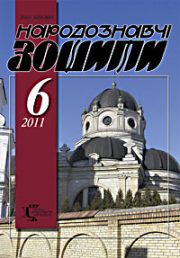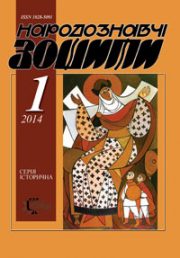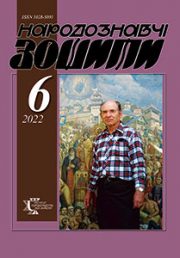The Ethnology Notebooks. 2024. № 2 (182), 333—359
UDK [39:728.012:747](=161.2:477.81/.82-2):303.446″1920/1930″
DOI https://doi.org/10.15407/nz2025.02.333
THE VERNACULAR ARCHITECTURE OF WESTERN POLISSIA. BASED ON RESEARCH MATERIALS FROM THE 1920S—1930S
LONCHUK Serhii
- ORCID ID: https://orcid.org/0009-0004-2489-3947
- PhD student,
- The Ethnology Institute of the National Academy of Sciences of Ukraine,
- department of Historical Ethnology,
- 15, Svobody Avenue, 79000, Lviv, Ukraine,
- Contacts: e-mail: serhiy.lonchuk@gmail.com
Abstract. Introduction. General features, regional peculiarities and local specificities of dwellings constitute one of the main signs of traditional ethnic culture or a characteristic of the ethnic group in general.
Today, researchers have greater access to scientific sources, including foreign ones, some of which were previously inaccessible to Ukrainian scientists. This provides new opportunities for a renewed understanding and study of vernacular architecture in general, and the vernacular architecture of Western Polissia in particular. Full-fledged research in this area requires, among other things, extensive involvement of the works of Polish ethnologists and architects from the 1920s—1930s. A comprehensive analysis and introduction of these works into scientific circulation will allow for a more complete and objective exploration of the chosen topic, which underscores the relevance of this research.
The purpose of this article is to analyze and characterize the vernacular construction of dwelling and household buildings in Western Polissia based on materials from field research and inventories of vernacular architecture from the 1920s—1930s.
The object of the research is the vernacular architecture of Western Polissia, while the subject is the layout of settlements, estates, and yards; planning, constructional peculiarities, building materials and techniques, heating systems, and interiors of dwellings, as well as household buildings and small architectural forms.
The main methods used in the research are comparative, typological, and comprehensive analysis methods.
The territory of the research includes parts of Western Polissia, specifically certain villages in the Liuboml, Kovel, Kamin-Kashyrskyi, and Brest areas.
Conclusion. According to the analyzed materials, the studied villages mostly had a street layout. There were various variants of free-standing and connected yard layouts, as well as transitional types — combinations of a free-standing yard with a connected or enclosed yard. The most common were three-chamber dwellings (dwelling + passage + storeroom), though two-chamber dwellings (dwelling + passage) were also found. In several villages, there were different variants of dwellings with two rooms, but only in Verbka was the two-room, one-sided dwelling (dwelling + kitchen + passage + storeroom) the most common. The constructional peculiarities, building materials and techniques, heating system, and interior of the dwelling described generally reflect Western Polissia features.
Keywords: Polissia, vernacular architecture, yard, dwelling, layout, building materials, constructional peculiarities, heating system, interior, household buildings.
Received 4.03.2025
REFERENCES
- Hlushko, M. (2008). Methodology of Field Ethnographic Research: A Guidebook. Lviv: Publishing Center of the I. Franko National University of Lviv [in Ukrainian].
- Verhovska, M. (2013). Housing of Polissia in research of Ukrainian scientists XIX — the beginning of the XXI century. Scientific notes on Ukrainian history, 33, 253—258 [in Ukrainian].
- Hilevych, I. (2008). The expeditional exploration of Polissia in a post-war period (1944 — the Beginning of the 1960-s). Proceedings of History Faculty of Lviv University, 9, 116—128 [in Ukrainian].
- Danyliuk, A. (1998). To the history of research on the traditional vernacular architecture of Polissia. Scientific notes of the Museum of folk architecture and rural life in Lviv, 1, 42—46 [in Ukrainian].
- Radovych, R. (2017). Polissia dwelling: cultural and genetic origins and evolutionary processes: monograph. Lviv: The Ethnology Institute of the National Academy of Sciences of Ukraine [in Ukrainian].
- Radovych, R. (2012). Traditional housing of Western Polissia: peculiarities and development dynamics). Visnyk of the Lviv University. Series History, 47, 63—105 [in Ukrainian].
- Krassowski, Cz. (1984). From the memories about Professor Jan Zachwatowicz. Ochrona Zabytkow, 37 (2), 93—99 [in Polish].
- Rozbicka, M. (Ed.). (2020). Foreword. In: M. Rozbicka. Studies on the History of Architecture and Urban Planning in Poland. Scientific Collections of the Department of Polish Architecture of the Faculty of Architecture of the Warsaw University of Technology from a 100-Year Perspective (Vol. 3, pp. 5—6) [in Polish].
- Sosnowski, O. (1926). The Department of Polish Architecture of the Warsaw University of Technology. Architektura i Budownictwo, 5, 3—18 [in Polish].
- Wolkowski, W., & Rozbicka, M. (Ed.). (2020). Contributions to the interwar history of the Department of Polish Architecture. In: M. Rozbicka. Studies on the history of architecture and urban planning in Poland (Vol. 3, pp. 9—34). Warsaw University of Technology [in Polish].
- Rozbicka, M., & Kunkel, R. (2018). Small-Scale Church Architectural Forms on the Borderlands of the Polish-Lithuanian Commonwealth in Research, Studies, and Designs (1900—1939): On the Margins of the Rural Inventory Program of the Department of Polish Architecture of the Faculty of Architecture of the Warsaw University of Technology. In: R. Kunkel. Studies on the History of Architecture and Urban Planning in Poland (Vol. 1, pp. 9—41) [in Polish].
- (1928). The Scientific Collections of the Department of Polish Architecture of the Faculty of Architecture of the Warsaw University of Technology. Rural Inventory Albums. Album No. 237. Drawings No. 237_01—237_39. Natalia Borowska. Inventory of the village of Werbka, Gmina Kolodnica, Kovel County, Wolyn Voivodeship.
- (1932). The Scientific Collections of the Department of Polish Architecture of the Faculty of Architecture of the Warsaw University of Technology. Rural Inventory Albums. Album No. 360. Drawings No. 360_01—360_34 + Measurement Notes. Inventory of the village of Pereszpa, Gmina Pulmo, Luboml County, Wolyn Voivodeship.
- (1933). Scientific Collections of the Department of Polish Architecture of the Faculty of Architecture of the Warsaw University of Technology. Rural Inventory Albums. Album No. 408. Drawings No. 408_01—408_43. Inventory of the village of Lanska, Gmina Oltusz, Brest-on-the-Bug County, Polesian Voivodeship.
- Bienkowski, W., & Rostworowski, E. (Ed.), (1981). Pietkiewicz Czeslaw (1856—1936). In: E. Rostworowski. Polish Biographical Dictionary. Piatkiewicz Bronislaw — Pniewski Wladyslaw (Vol. XXVI, pp. 153—154). Wroclaw: Publishing House of the Ossolinski National Institute [in Polish].
- Pietkiewicz, Cz. (1929). From the ethnography of Volyn Polesie: The village of Czorcze. Wiedza i Zycie, 8—9, 525—542 [in Polish].
- Pietkiewicz, Cz. (1928). Rechytsa Polesie: Ethnographic Materials (Part I). Krakow [in Polish].
- Tarnavskyi, R. (2017). Department of Ethnology of the University of Lviv. Classical Period (1910—1947): Monograph. Lviv: Ivan Franko National University of Lviv [in Ukrainian].
- Tarnavskyi, R. (2014). Jagiello, Wladysław. In: Encyclopedia. Ivan Franko National University of Lviv: in two volumes (Vol. II, p. 713). Ivan Franko National University of Lviv [in Ukrainian].
- Jagiello, W., & Trapszyc, A. (Ed.). (2008). Fishing of the Tuchola Borowiaks: An Ethnographic Essay. Torun: The Maria Znamierowska-Pufferowa Ethnographic Museum in Torun [in Polish].
- Jagiello, W., & Gajek, J. (Ed.). (1947). Ethnographic Notes from the Outskirts of Liuboml. In: J. Gajek. Ethnographic Works and Materials (Vol. VI, pp. 127—152). Lublin [in Polish].
- Makarchuk, S. (2012). Ethnographic research of daily routine of Ukrainian workmen in 50s—60s of 20th century. Visnyk of the Lviv University. Series History, 47, 22—34 [in Ukrainian].
- Hilevych, I. (2008). Ukrainian ethnology in a post-war decade and the field exploration of Polissia. Visnyk of the Lviv University. Series History, 43, 34—53 [in Ukrainian].
- Hilevych, I. (2013). Little-known work by Vasyl Pastushchyn on the traditional culture of the Polishchuks. Past and present of Volyn and Polissia. Folk culture and museums: scientific collection, 44, 123—128 [in Ukrainian].
- Hilevych, I. (2013). The life and scientific work of ethnologist, historian and linguist Vasyl Pastushchyn (1889—1958). Visnyk of the Lviv University. Series History, 49, 245—272 [in Ukrainian].
- Borysenko, V. (2014). A Monograph of a Village ([From the Archives of the Scholar Vasyl Pastushchyn (1889—1958)]. Folk Art and Ethnology, 5, 69—71 [in Ukrainian].
- Pastushchyn, V. (2014). Drochevo of Berestia District in Polissia: A Monograph. Folk Art and Ethnology, 5, 72—108 [in Ukrainian].
- Pastushchyn, V., & Skrypnyk, G. (Ed.). (2014). Drochevo of Berestia District in Polissia: A monograph. Кyiv: M. Rylskyi Institute of Art Studies, Folkloristics and Ethnology of the NAS of Ukraine [in Ukrainian].
- Siletskyi, R.B., Pavliuk, S.P., Horyn, H.Y., & Kyrchiv, R.F. (Eds.). (1994). Rural settlements and peasant households. Ukrainian ethnology: A textbook (Pp. 437—454). Phoenix [in Ukrainian].
- Olkhovskyi, I.A. (2008). Bloody Volyn. The Ukrainian-Polish confrontation in the territories of Liuboml and Shatsk districts in 1939—1945 (Book 1). Kyiv: Hart [in Ukrainian].
- Puschuk, I.A. (2011). The tragedy of the Ukrainian-Polish confrontation in Volyn 1938—1944: Liuboml and Shatsk Districts. Lutsk: Tverdynia [in Ukrainian].
- Busel, V.T. (Ed.). (2005). Great Explanatory Dictionary of Modern Ukrainian Language: 250000 Words. Kyiv; Irpin: Perun [in Ukrainian].
- Kosmina, T.V. (2022). Rural housing of Podillia, late 19th—20th century. Historical and ethnographic research. Reprint edition. Kyiv: Tsentr uchbovoyi literatury [in Ukrainian].
- Danyliuk, A. (2001). Traditional architecture of the regions of Ukraine: Polissia. Lviv [in Ukrainian].
- Funduklei, I. (1852). Statistical description of the Kiev Governorate (Part 1). Printing House of the Ministry of Internal Affairs [in Russian].
- Danyliuk, A. (1975). Closed farmsteads in Polissia. Folk Art and Ethnography, 4, 102—103 [in Ukrainian].
- Hurkow, V.S., & Hoshko, R.Y. (1988). Settlements. In: Polissia. Material Culture (Pp. 279—333). Kyiv: Naukova dumka [in Russian].
- Danyliuk, A. (2007). Peculiarities of traditional vernacular architecture in the Liuboml district. Past and present of Volyn and Polissia. Liuboml in the history of Ukraine and Volyn, 25,225—227 [in Ukrainian].
- Daniluk, A. (1993). Our house: an ethnographic essay on traditional Polissia dwelling. Lutsk: Nadstyria [in Ukrainian].
- Verhovskyi, S. (1979). Ancient vernacular architecture of Ukrainian and Belarusian Polissia. Folk Art and Ethnography, 2, 74—80 [in Ukrainian].
- Brytsun-Khodak, M. (2002). The Chronicle Land of the Drevlians: Archaeology, History, Ethnography: A Historical and Local History Study. Korosten: Druk [in Ukrainian].
- Verhovskyi, S., & Verhovska, M. (2007). To the study of traditional architecture of Volyn Polissia. Past and present of Volyn and Polissia. Liuboml in the history of Ukraine and Volyn, 25, 265—270 [in Ukrainian].
- Danyliuk, A. (1994). Ancient vernacular dwelling in Shatsk National Park. Folk Art and Ethnography, 2/3, 70—73 [in Ukrainian].
- Archive of EI NAS of Ukraine — Archive of the Ethnology Institute of the National Academy of Sciences of Ukraine. F. 1. Op. 2. Ref. 604a. Radovych R.B. Report on the expedition work in Volyn Region (Polissia) (collection of materials on the topic «Folk Architecture»), July 12—16, 2010 [in Ukrainian].
- Tokarev, S.A. (1947). Northern Ukrainian expedition of 1945. The Institute of Ethnography. Short Messages (Pp. 27—35) [in Russian].
- Radovych, R. (2012). On Polissian «Posvit» lighting (technological and cultural genetic aspects). The Ethnology Notebooks, 5, 799—817 [in Ukrainian].
- Kharuzin, A. (1907). Slavic dwelling in the North-Western region: From materials on the history of the development of Slavic dwellings. Vilna [in Russian].
- Kolberg, O. (1964). Chelm [Voivodeship]: Ethnographic Image (Part 1). In: Complete Works (Vol. 33). Wroclaw; Poznan: Ludowa Spoldzielnia Wydawnicza [in Polish].
- Archive of SSCPCHMD — Archive of the State Scientific Center for the Protection of Cultural Heritage from Man-made Disasters. F. Kamin-Kashyrskyi-2012. Ref. Rad.-1 (+ Appendices: 1-d—6-d) [in Ukrainian].
- Svyryda, R. (1979). Equipment of traditional dwelling of Right-bank Polissia. Folk Art and Ethnography, 3, 56—63 [in Ukrainian].
- Archive of SSCPCHMD. F. Sarny-2008. Ref. Rad.-1 (+ Appendices: 1-d—18-d) [in Ukrainian].
- Archive of SSCPCHMD. F. Volodymyrets-2009. Ref. Rad.-1 (+ Appendices: 1-d—21-d) [in Ukrainian].
- Staszczak, Z. (1963). Peasant Construction in the Lublin Voivodeship (19th and 20th Centuries) (Vol. XXIV). Wroclaw: PTL [in Polish].
- Archive of MFARL — Archive of the Museum of folk architecture and rural life in Lviv named after Klymentii Sheptytskyi. F. Materials of expeditions. Ref. ЗВ-52. Danyliuk A.H. Report on the work of the expedition to Polissia (Rivne region), June 18—25, 1984 [in Ukrainian].
- Hrinchenko, B. (Ed.). (1958—1959). Dictionary of the Ukrainian language (Vol. 3: O—P). Publishing House of the Academy of Sciences of the Ukrainian SSR. (Reprint of the 1909 edition) [in Ukrainian].
- Blomkvist, E.E. (1956). Peasant buildings of Russians, Ukrainians, and Belarusians (settlements, dwellings, and household structures). In: East Slavic Ethnographic Collection (Pp. 3—458). Moscow: Publishing House of the USSR Academy of Sciences [in Russian].
- Sabalenka, E.R., Hurkow, U. S., & Ivanow, U. M. (1973). Belarusian vernacular dwelling. Minsk: Navuka i tekhnika [in Belarusian].
- Molchanova, L.A. (1968). Material culture of Belarusians. Minsk: Nauka i tekhnika [in Russian].
- Moszynski, K. (1928). Eastern Polissia: Ethnographic Materials from the Eastern Part of the Former Mozyr County and the Rzeczyca County. Warsaw: Wydawnictwo Kasy im. Mianowskiego [in Polish].
- Zahlada, N., & Hlushko, M. (Ed.). (2001). From the report of the 1934 ethnographic expedition. In: M. Hlushko. The Last Expedition of Nina Zahlada: Instead of an Afterword, Notes of the Shevchenko Scientific Society (Vol. CCXLII, pp. 443—505). Lviv: Shevchenko Scientific Society [in Ukrainian].
- Vovk, Khv. (1995). Ethnographic features of the Ukrainian people. In: Studies in Ukrainian Ethnography and Anthropology (Pp. 39—218). Kyiv: Mystetstvo [in Ukrainian].







